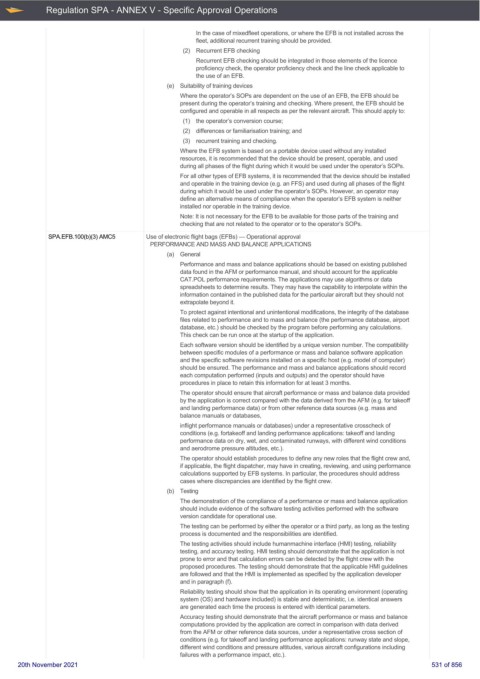Page 531 - UK Air Operations Regulations (Consolidated) 201121
P. 531
~
~ Regulation SPA - ANNEX V - Specific Approval Operations Centrik
In the case of mixedfleet operations, or where the EFB is not installed across the
fleet, additional recurrent training should be provided.
(2) Recurrent EFB checking
Recurrent EFB checking should be integrated in those elements of the licence
proficiency check, the operator proficiency check and the line check applicable to
the use of an EFB.
(e) Suitability of training devices
Where the operator’s SOPs are dependent on the use of an EFB, the EFB should be
present during the operator’s training and checking. Where present, the EFB should be
configured and operable in all respects as per the relevant aircraft. This should apply to:
(1) the operator’s conversion course;
(2) differences or familiarisation training; and
(3) recurrent training and checking.
Where the EFB system is based on a portable device used without any installed
resources, it is recommended that the device should be present, operable, and used
during all phases of the flight during which it would be used under the operator’s SOPs.
For all other types of EFB systems, it is recommended that the device should be installed
and operable in the training device (e.g. an FFS) and used during all phases of the flight
during which it would be used under the operator’s SOPs. However, an operator may
define an alternative means of compliance when the operator’s EFB system is neither
installed nor operable in the training device.
Note: It is not necessary for the EFB to be available for those parts of the training and
checking that are not related to the operator or to the operator’s SOPs.
SPA.EFB.100(b)(3) AMC5 Use of electronic flight bags (EFBs) — Operational approval
PERFORMANCE AND MASS AND BALANCE APPLICATIONS
(a) General
Performance and mass and balance applications should be based on existing published
data found in the AFM or performance manual, and should account for the applicable
CAT.POL performance requirements. The applications may use algorithms or data
spreadsheets to determine results. They may have the capability to interpolate within the
information contained in the published data for the particular aircraft but they should not
extrapolate beyond it.
To protect against intentional and unintentional modifications, the integrity of the database
files related to performance and to mass and balance (the performance database, airport
database, etc.) should be checked by the program before performing any calculations.
This check can be run once at the startup of the application.
Each software version should be identified by a unique version number. The compatibility
between specific modules of a performance or mass and balance software application
and the specific software revisions installed on a specific host (e.g. model of computer)
should be ensured. The performance and mass and balance applications should record
each computation performed (inputs and outputs) and the operator should have
procedures in place to retain this information for at least 3 months.
The operator should ensure that aircraft performance or mass and balance data provided
by the application is correct compared with the data derived from the AFM (e.g. for takeoff
and landing performance data) or from other reference data sources (e.g. mass and
balance manuals or databases,
inflight performance manuals or databases) under a representative crosscheck of
conditions (e.g. fortakeoff and landing performance applications: takeoff and landing
performance data on dry, wet, and contaminated runways, with different wind conditions
and aerodrome pressure altitudes, etc.).
The operator should establish procedures to define any new roles that the flight crew and,
if applicable, the flight dispatcher, may have in creating, reviewing, and using performance
calculations supported by EFB systems. In particular, the procedures should address
cases where discrepancies are identified by the flight crew.
(b) Testing
The demonstration of the compliance of a performance or mass and balance application
should include evidence of the software testing activities performed with the software
version candidate for operational use.
The testing can be performed by either the operator or a third party, as long as the testing
process is documented and the responsibilities are identified.
The testing activities should include humanmachine interface (HMI) testing, reliability
testing, and accuracy testing. HMI testing should demonstrate that the application is not
prone to error and that calculation errors can be detected by the flight crew with the
proposed procedures. The testing should demonstrate that the applicable HMI guidelines
are followed and that the HMI is implemented as specified by the application developer
and in paragraph (f).
Reliability testing should show that the application in its operating environment (operating
system (OS) and hardware included) is stable and deterministic, i.e. identical answers
are generated each time the process is entered with identical parameters.
Accuracy testing should demonstrate that the aircraft performance or mass and balance
computations provided by the application are correct in comparison with data derived
from the AFM or other reference data sources, under a representative cross section of
conditions (e.g. for takeoff and landing performance applications: runway state and slope,
different wind conditions and pressure altitudes, various aircraft configurations including
failures with a performance impact, etc.).
20th November 2021 531 of 856

